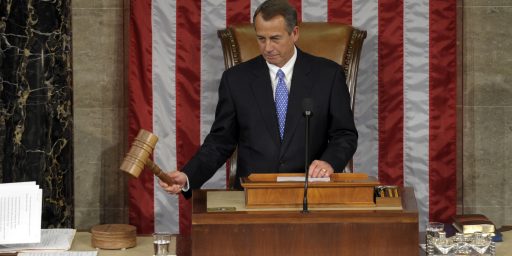Reid and Boehner Plans: Much in Common
While I have read the basics of both plans (and they seemed relatively similar to me at this point), the National Journal has gone to the trouble of outlining Six Similarities Between the Boehner and Reid Debt Plans.
While I may well be missing something, it seems that the main reasons Republicans don’t like the Reid plan is because it has a Democrats name on it and, likewise the Democrats don’t like the Boehner plan because an R’s name is on it.
One wonders if, like the old Pepsi Challenge, you took the names off the plans whether partisans could much tell the difference.
While the posturing is likely to continue, perhaps this all paves the way for a compromise.






The biggest difference to me outside the numbers and the specific cuts is the structure and on that I think the Reid Plan is superior.
There is no rational reasons for a two-step increase in the debt ceiling like the Boehner Plan contemplates
Yes, that part of the Boehner plan strikes me as political circus (of course, this whole situation has been a political circus, so i guess it fits thematically).
The two-step is a stupid legislative trick to drag this all out again, I would never even consider it given that real honest to god uncertainty it will bring on (not the fake uncertainty everyone was talking about 6 month’s ago).
Well, as I say, we shouldn’t be surprised that the GOP wants to make 2012 about taxes. It’s a game plan that has worked for them for decades.
Of course, we are in “how low can you go” territory on taxes, and with $14T debt, and 9.1% unemployment, the idea that the most important thing is to keep taxes at an all time low might be kind of stupid.
It might not be the best GOP plan for 2012 after all.
If you think it irrelevant that Boehner would have us do all this again come spring, then I suppose the two proposals might look essentially the same. It strikes me as an obvious distinction and good reason to oppose the Republican plan.
I also suspect there are differences in how the two plans achieve their spending cuts; I have yet to read a clear description of the GOP cuts.
I think ya’ll are missing something regarding the benefits of a 2-step process. There is not enough time to get entitlement reform or tax reform into a bill. Plus, it may be that a supercommittee with a trigger that will force them to stay at the bargaining table would be the only way to get those politically unpopular tasks accomplished.
Obviously this is no longer a hot topic. However, there were substantive reasons to not like the Reid plan:
* The Reid plan didn’t include a vote on the Balanced Budget Amendment. Obviously the BBA isn’t going anywhere, but this was important to many House Republicans, and is in the final deal.
* The Reid plan would have deemed a budget into existence for 2012 and 2013 ( http://hotair.com/archives/2011/07/29/whats-so-wrong-with-reids-bill/ ). This was my main reason to oppose the plan.
* The Reid plan played accounting tricks to inflate the numbers (this is the motivation for Paul Ryan’s “Let’s Cover the Moon With Yogurt” speech: http://www.breitbart.tv/rep-paul-ryan-destroys-reid-bill-in-blistering-speech-lets-cover-the-moon-with-yogurt/ ). This allowed Reid to claim one dollar in spending cuts for each dollar increase in the debt ceiling. According to the CBO, there were less than 50 cents spending cuts for each dollar increase in the debt ceiling. This ratio wasn’t a big deal to me, but it definitely was a big deal to many House Republicans who had vowed that they wouldn’t go along with anything other than dollar for dollar cuts.